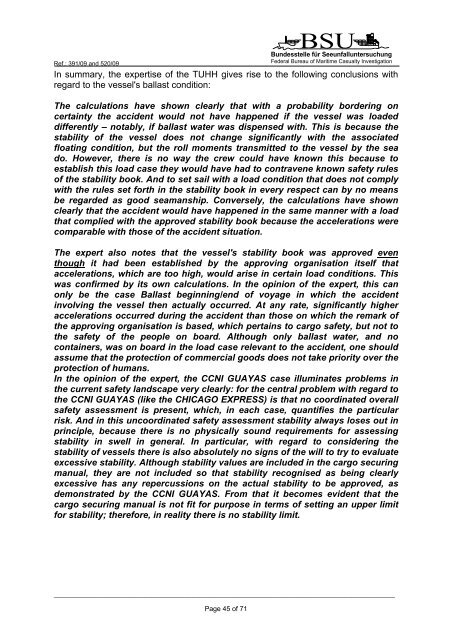SUB-COMMITTEE ON STABILITY AND LOAD LINES AND ON ...
SUB-COMMITTEE ON STABILITY AND LOAD LINES AND ON ...
SUB-COMMITTEE ON STABILITY AND LOAD LINES AND ON ...
You also want an ePaper? Increase the reach of your titles
YUMPU automatically turns print PDFs into web optimized ePapers that Google loves.
Ref.: 391/09 and 520/09<br />
BSU<br />
Bundesstelle für Seeunfalluntersuchung<br />
Federal Bureau of Maritime Casualty Investigation<br />
In summary, the expertise of the TUHH gives rise to the following conclusions with<br />
regard to the vessel's ballast condition:<br />
The calculations have shown clearly that with a probability bordering on<br />
certainty the accident would not have happened if the vessel was loaded<br />
differently – notably, if ballast water was dispensed with. This is because the<br />
stability of the vessel does not change significantly with the associated<br />
floating condition, but the roll moments transmitted to the vessel by the sea<br />
do. However, there is no way the crew could have known this because to<br />
establish this load case they would have had to contravene known safety rules<br />
of the stability book. And to set sail with a load condition that does not comply<br />
with the rules set forth in the stability book in every respect can by no means<br />
be regarded as good seamanship. Conversely, the calculations have shown<br />
clearly that the accident would have happened in the same manner with a load<br />
that complied with the approved stability book because the accelerations were<br />
comparable with those of the accident situation.<br />
The expert also notes that the vessel's stability book was approved even<br />
though it had been established by the approving organisation itself that<br />
accelerations, which are too high, would arise in certain load conditions. This<br />
was confirmed by its own calculations. In the opinion of the expert, this can<br />
only be the case Ballast beginning/end of voyage in which the accident<br />
involving the vessel then actually occurred. At any rate, significantly higher<br />
accelerations occurred during the accident than those on which the remark of<br />
the approving organisation is based, which pertains to cargo safety, but not to<br />
the safety of the people on board. Although only ballast water, and no<br />
containers, was on board in the load case relevant to the accident, one should<br />
assume that the protection of commercial goods does not take priority over the<br />
protection of humans.<br />
In the opinion of the expert, the CCNI GUAYAS case illuminates problems in<br />
the current safety landscape very clearly: for the central problem with regard to<br />
the CCNI GUAYAS (like the CHICAGO EXPRESS) is that no coordinated overall<br />
safety assessment is present, which, in each case, quantifies the particular<br />
risk. And in this uncoordinated safety assessment stability always loses out in<br />
principle, because there is no physically sound requirements for assessing<br />
stability in swell in general. In particular, with regard to considering the<br />
stability of vessels there is also absolutely no signs of the will to try to evaluate<br />
excessive stability. Although stability values are included in the cargo securing<br />
manual, they are not included so that stability recognised as being clearly<br />
excessive has any repercussions on the actual stability to be approved, as<br />
demonstrated by the CCNI GUAYAS. From that it becomes evident that the<br />
cargo securing manual is not fit for purpose in terms of setting an upper limit<br />
for stability; therefore, in reality there is no stability limit.<br />
_____________________________________________________________________________________________________<br />
Page 45 of 71
















